The Galápagos Islands are incredible. They are the place where Charles Darwin came up with his theory of evolution; a group of islands on the equator off the coast of Ecuador; and home to endemic species of fearless animals including giant tortoises and sea turtles, land and marine iguanas, equatorial penguins, florescent flamingos, swarming schools of hammerhead sharks, and gigantic whale sharks. A trip to the Galapagos Islands is truly an incredible experience.
However, in order to have the best experience possible, it’s important to plan your trip well. These are my tips for planning a trip to the Galapagos Islands that will make the most of every moment.
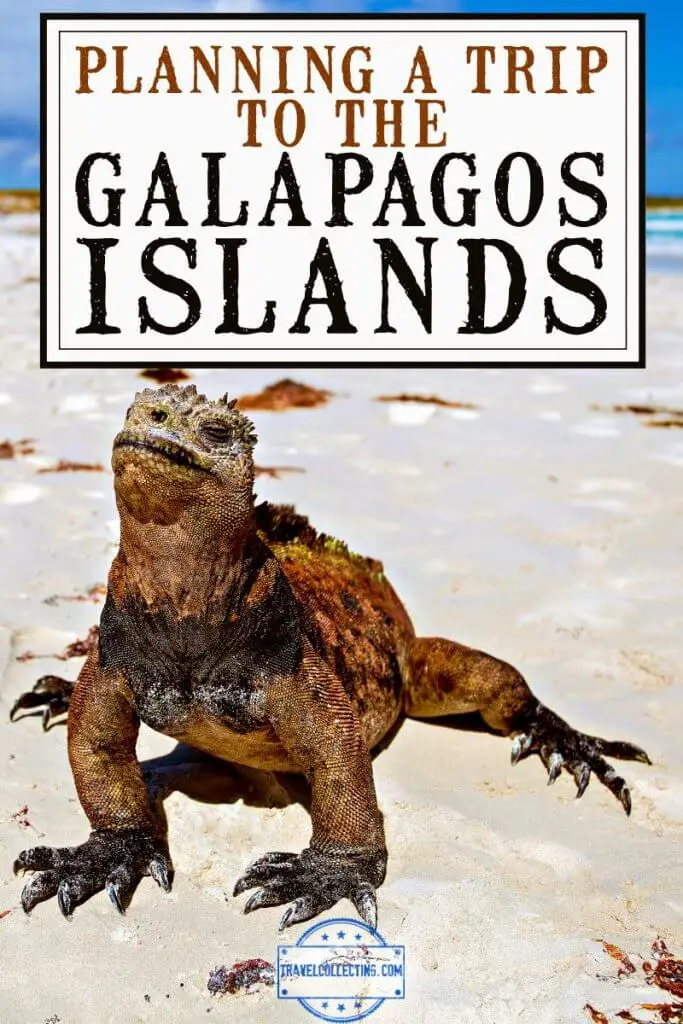
Please note that some of the links below may be affiliate links. If you make a purchase through these links, I earn a small commission at no additional cost to you. Read my Disclaimer for more information.
Tips for Planning a Trip to the Galapagos Islands
So, you’ve decided to visit Galapagos Islands. That’s the first step. Now you need to figure out how to plan a trip to Galapagos Islands. That’s what this post is all about.
Planning a trip to Galapagos Islands can be daunting at the start. Maybe you are wondering “Can you travel to the Galapagos Islands independently?” Well, yes, you can. You may choose to go on a cruise (a top pick is this 5-day luxury cruise) or a land-based tour, to make it easy (there are plenty of Galapagos Islands tours to choose from – check out a selection of land-based multi-day tours here), but you can also totally visit the Galapagos on your own.
Subscribe to monthly updates with tips for planning, travel inspiration and trip ideas and get instant access to the free PDF of this
Guide to Planning a Trip to Galapagos Islands
This guide will help you even if you take a cruise or a tour, but will of special help if you are planning to travel independently.
1. Choose when to go
Your Galapagos trip planning will depend quite a lot on when you go.
Can you go to the Galapagos Islands any time of the year? Yes, you can; however, there are several things to consider when choosing the best time to go to Galapagos Islands and which Galapagos Islands are best to visit. The two major consideration are the weather and the wildlife.
There are two main seasons:
December to May is the warm and wet season. Despite this classification, it usually only rains for a short time each day and somewhat ironically, these are also the sunniest months. These months are best for schooling hammerheads and most other sharks. Many animals and birds breed and you can often see nesting and babies during these months.
From June to November is the cool and dry season. Although there is less rain, these months also see the Gurua mists, so they are less sunny in general. In these months, the weather is also windy and the seas are rougher. However, there is more marine life at this time of year, so these are the peak diving months. They are the best time of year for whale sharks and mola mola (sunfish). These months are also best for seabirds such as albatrosses and penguins.
2. Decide what you want to do and what to see in Galapagos Islands
What you want to see and do affects where to go in Galapagos. Almost everything centers around the wildlife, but there are choices for the best things to do and best places to visit in Galapagos Islands.
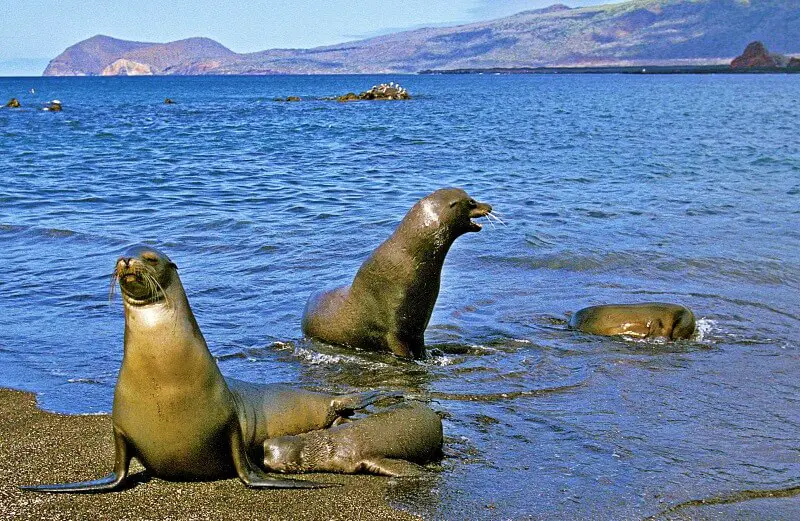
3. Decide which islands to visit in Galapagos
Choosing which Galapagos Islands to visit is tricky in some ways, because they each have their own distinct wildlife and weather. However, what helps make your choice easier is that, unless you have very specific birds or animals you wish to see, it is hard to go too wrong, as they are all amazing in their own way.
Where are the Galapagos Islands?
What country are the Galapagos Islands part of? They belong to Ecuador.
Where are the Galapagos Islands located? The Galapagos Islands location is along the equator, more than 500 miles offshore from mainland Ecuador.
How many Galapagos Islands are there?
There are 13 main islands in the archipelago, plus plenty of tiny islets. There are three main inhabited islands (Santa Cruz, Isabela and San Cristobal), plus one other smaller inhabited island, Floreana. The remainder are non- inhabited islands that can only be visited by boat.
Map of the Galapagos Islands
The best islands in the Galapagos
If you are wondering which islands to visit in Galapagos, well, the answer depends on when you go and what you want to see.
Boat-based trips typically visit either the east islands or the west islands. They all usually leave from Santa Cruz Island, which is in the middle of the archipelago.
The Eastern Islands
Highlights:
- waved albatross
- red-footed boobies
- land iguanas
- the best Galapagos islands for seeing penguins and sharks while snorkeling
Eastern islands (and highlights) include:
Genovesa
- birds
- Darwin Bay
- Prince Phillips Steps hiking trail
Floreana
- Punta Cormorant flamingo lagoon
- Post Office Bay
- Devil’s Crown (snorkeling)
Espanola
- breeding site for waved albatrosses
- marine iguanas
- sea lions
San Cristobal
- Puerto Baquerizo Moreno
- San Cristobal Interpretation Centre
- Punta Pitt (red-footed boobies)
- Leon Dormido (Sleeping Lion) rock
Santa Fe
- land iguanas
- tall opuntia cactuses
- sea turtles
- manta rays
North Seymour
- seabirds’ breeding grounds
- large colony of sea lions
The Western Islands
Highlights:
- lava landscapes
- great beaches
- coral
- flightless cormorants
- mangrove and medium tree finches
- whales and dolphins
- giant sunfish (mola mola)
- more fur seals and marine iguanas
- more giant tortoises in the wild
Western islands (and highlights) include:
Isabela
- giant land tortoises
- humpback whales
- nesting waved albatrosses
Santiago:
- James Bay
- colonies of fur sea lions
Fernandina
- Punta Espinoza lava fields
- flightless cormorant nesting site
Bartolome
- panoramic views of lava from its peak
- Pinnacle Rock
The northern islands
Live aboard dive trips to the Galapagos Islands are usually 8 days/ 7 nights and center around Darwin and Wolfe Islands or sometimes the northern end of Isabela Island. For diving, these are the best islands. Galapagos marine life is plentiful and includes hammerhead sharks, whale sharks, enormous mola mola (sun fish) and penguins. Darwin and Wolf Islands are rocky outcrops about 90 miles/ 145 km north of the main cluster of islands.
The inhabited islands
Santa Cruz (and Baltra and North Seymour)
Santa Cruz is the main island and lies between Isabela and San Cristobal. Most cruises leave from here. If you are doing a land-based trip, it’s a good place to start and get your bearings. There are a couple of good day trips and a couple of great dives, but it isn’t the best island Galapagos has, so don’t spend more than a few days here. The main town is Puerto Ayora.
On Santa Cruz is the Darwin Research Center (a good place to start your trip for an overview of the islands) as well as the El Chato Tortoise Reserve & lava tubes (a great place to see land tortoises in the (semi) wild and the lava tubes are cool) and Tortuga Bay (for flamingos and marine iguanas; you can visit yourself or on this day trip that includes The Cracks and Alemanes Beach).
You can do day trips to Floreana (you don’t get much time there though), Santa Fe (don’t bother if time is short), North Seymour (don’t miss it, great for bird life in season), Bartolome Island and Plazas. Good dives from Santa Cruz include Gordon Rocks for schools of hammerhead sharks and Cousin Rock for reef sharks, sea turtles and schools of barracuda.

Isabela
The main town is Puerto Villamil. This is possibly the best island to stay in Galapagos.
You can visit Concha y Perla Bay and Frigate Hill by yourself, as well as the Giant Tortoise Breeding Center, Flamingo Lagoon and Lava Tunnels by taking a taxi or renting a bicycle.
Isabela is one of the best places to visit in the Galapagos Islands for snorkeling. Highlights include Los Tintoreras (marine iguanas, penguins, sea turtles, and often reef sharks) and Los Tuneles (with a good chance to see manta rays, turtles and giant seahorses). For land adventures, don’t miss a hike to Sierra Negra.
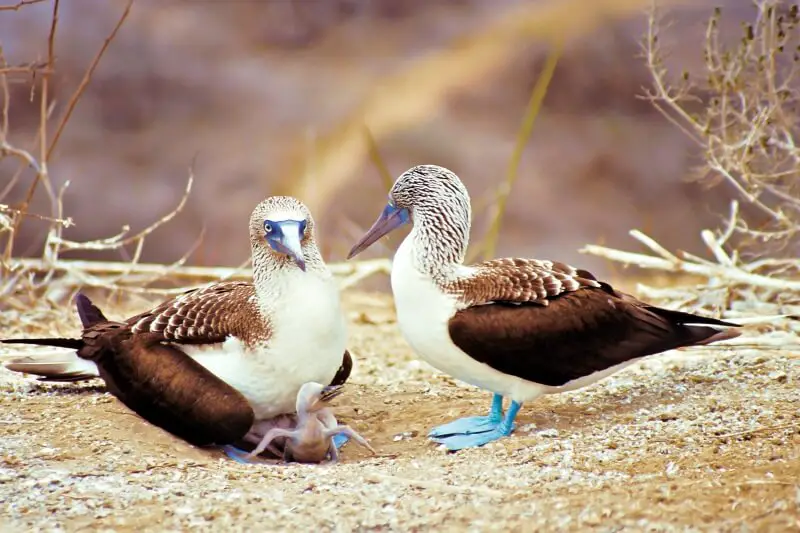
San Cristobal
The main town is Puerto Baquerizo Moreno. This is my other choice for the best Galapagos Island to stay on. You can visit La Loberia for the sunset and sea lions on your own, but there are also great day trips here. Top picks include:
- Isla Lobos (a top spot for snorkeling with sea lions)
- Kicker Rock AKA Leon Dormido or Sleeping Lion (more great snorkeling, plus blue-footed boobies and frigate birds),
- the 360 Tour, which circumnavigates the island, with a stop at Punta Pitt.
Don’t miss a day trip to Espanola Island, which is one of the best islands to visit in Galapagos to see waved albatrosses. You can also see marine iguanas, Darwin finches, blue footed boobies and more (in season).
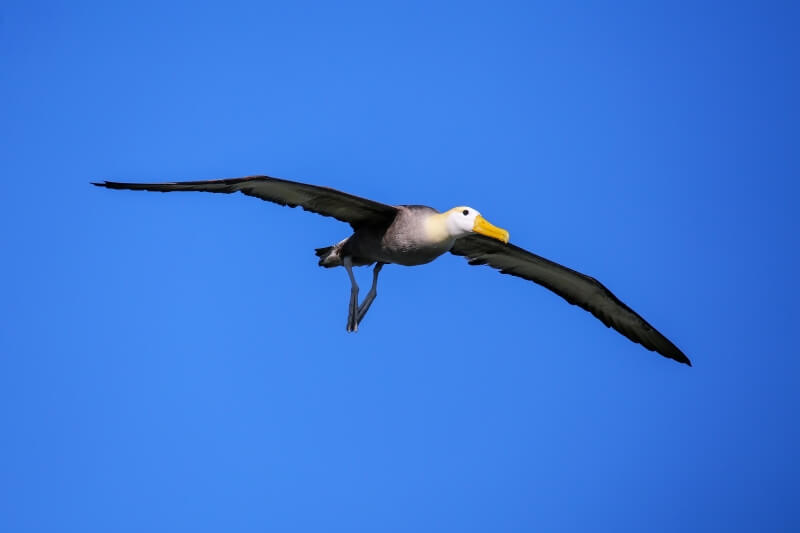
Floreana
The main town is Puerto Velasco Ibarra. It is one of the best islands in Galapagos to see sea lions, because there is a huge colony at La Loberia. Other highlights include sea turtles and marine iguanas, flamingos, Black Beach and Post Office Bay, where there is a barrel on the beach that you can post letters from.

If time is short, you can visit Floreana as a day trip from Santa Cruz.
4. Decide if you want a boat-based trip or a land-based trip
Can you visit the Galapagos Islands without taking a cruise? Yes, you can. Many argue that the best way to visit the Galapagos Islands is on a multi-day boat cruise, but that is not necessarily true anymore.
Boat trips used to be the only way to see the Galapagos and land-based trips were few and far between and definitely inferior. Nowadays, however, things have change. There are a lot of day trips you can do from land that are high quality. Both options are good choices, but they do have pros and cons.
I had always expected to do a boat-based trip, but Kevin gets seasick and couldn’t imagine trying to sleep on a boat. Plus, most Galapagos cruises are so expensive. So, when we heard from people who had actually done land-based trips how much they’d enjoyed them, I was convinced, and decided that the best way to see Galapagos Islands for me was an independent land-based trip.
5. Book boat cruise, land-based tour or day trips
Choosing a Boat Cruise
If you decide to take a cruise, choose the islands you want to visit, research cruises, then book your cruise.
Some things to consider include:
- Plan the length of your cruise
- Choose which itinerary (west or east islands) you want to do
- Pick the standard of boat you want
- Pick the type of boat (catamarans and bigger boats tend to be more stable)
- Choose the size of the boat you want
- Check availability if you have specific dates
- See if they include specific activities like diving, kayaking, horseback riding, cycling, etc.
Consider this 5-day cruise around the western islands or this 7-day southeastern Galapagos cruise.
Choosing a land-based tour
You can book a land-based tour so that the hotels, inter-island transfers and day tours are arranged for you. There are plenty of multi-day land trips to choose from. They typically visit several islands, so you can experience different wildlife. The advantage of booking a tour is that the arrangements are taken care of for you, as you will have a guide to assist you navigating flights, ferries and day trips.
Much of the advice that I received when first planning my trip to the Galapagos was from BJ, the owner of Retreatours. They run annual tours to the Galapagos Islands and you will be in great hands if you go with them!
Arranging Galapagos day trips for independent land- based trips
If you decide to do land-based, independent travel, you will want to decide on what tours you want to do, as this will help you determine which islands to visit and how long to spend on each island.
Some Galapagos travel tips
Trip schedules
Trips only go on certain days of the week. There are several agencies you can book with, but they will all book the same operators, so it doesn’t really matter who you book through. Typically, you will either book with an agency on each island or you can book with Viator. I have recommended specific day tours, but you can see their full selection of trips and tours here. An advantage of booking with Viator is the ease of payment. If you book directly with an agency, it can be hard to pay.
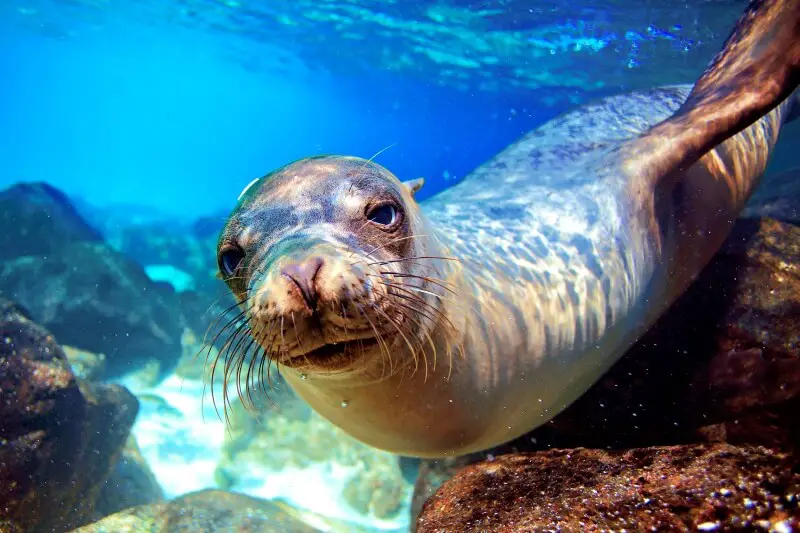
Recommended day tours
Santa Cruz
- El Chato Tortoise Reserve & lava tubes: land tortoises; lava tubes
- Tortuga Bay and La Loberia Island: flamingos; marine iguanas; yacht cruise
- North Seymour: sea birds, blue-footed boobies; sea lions
- Plazas: sea lions; land and hybrid iguanas
- Gordon Rocks (dive): schools of hammerhead sharks
Isabela
- Los Tintoreras: marine iguanas; penguins; sea turtles; reef sharks
- Los Tuneles: manta rays; sea turtles; giant seahorses
- hike to Sierra Negra: lava fields; views (in good weather)
San Cristobal
- Isla Lobos: snorkeling with sea lions
- Kicker Rock AKA Leon Dormido (Sleeping Lion): snorkeling; blue-footed boobies; frigate birds
- Galapaguera and Punta Pitt: tortoises; all three species of boobies
- 360 Tour: hiking and snorkeling; frigates, pelicans; boobies; sea lions
- Espanola Island: waved albatrosses, blue-footed boobies; iguanas; sea lions; Galapagos sharks
Dive schedules
Note that the dive schedule is set by the national park service and is updated in March each year. So, if you book a dive before March, the day that your operator is able to dive that particular site may change. You may not mind what dive site is available when you’re there, but I really wanted to dive Gordon Rocks (from Santa Cruz) to see the hammerhead sharks, so I didn’t want to be locked into a particular date. For this reason, I tentatively booked the dive and tours on other days, but didn’t confirm and pay until after the dive schedule was confirmed.
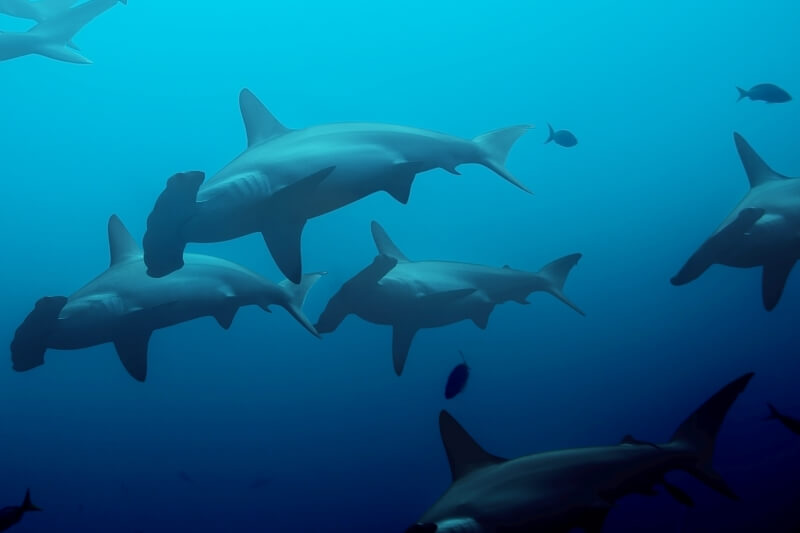
Booking day tours
Booking Galapagos tours can be a bit tricky. Most of the operators don’t take PayPal and either don’t accept credit cards or charge a huge supplement for credit card payments. You need to pay by Moneygram or direct bank transfer. Which is a pain. This is why booking through Viator can make it much easier. It’s possible to pay cash on the island of course, and you can get last minute discounts, but you do take a chance that the trips you want will be booked out.
Subscribe to monthly updates with tips for planning, travel inspiration and trip ideas and get instant access to the free PDF of this
Guide to Planning a Trip to Galapagos Islands
6. Book your flight to the Galapagos
Flights book up, so you will want to do this as soon as you can.
There are two main airports (Baltra Airport for Santa Cruz and San Cristobal), with flights from Quito and Guayaquil, both in Ecuador.
Book a flight to the Galapagos here.
TIP: I recommend taking a flight from the mainland to one of the airports, then a flight back to the mainland from the other airport, with boats and/ or flights between islands. This will let you see as much as possible without backtracking.
Consider spending a few extra days in Ecuador. Check out my Ecuador Guide for things to do.
7. Plan getting around the Galapagos
If you have booked a cruise or tour, then this will be taken care of for you.
If you are doing an independent land-based trip, the first thing after deciding which islands to visit, is to book flights (especially inter-island flights), as they can book up months in advance.
Recommended itinerary: For a land-based trip, I recommend flying from mainland to Santa Cruz, then take a boat to Isabela (buy a boat ticket from Santa Cruz to Isabela here), then fly to San Cristobal and from there, fly back to the mainland.
8. Book your hotel
If you book a cruise, this may be taken care of, though you may decide to add an extra day or two.
If you are doing a land-based trip and arranging it yourself, then you will need to find and book your accommodation.
Accommodations on Galapagos can also book out early. It is possible to get last-minute deals on both accommodations and tours, but you take a chance that the ones you want will be sold out. I prefer not to take the chance, but if you are traveling to Galapagos on a budget, then that is definitely an option.
When choosing accommodations, the location is something to consider. None of the towns are very big, but it can be fun to stay near the beach. Be aware, however, that those sea lions that are so cute during the day, may keep you awake with all their noise at night. Still, being close to the pier is convenient for the boats or beach makes you feel more connected to the wildlife.
Check my complete guide to the Best Accommodations in the Galapagos Islands here.
Hotels
If you start looking at hotels, you’ll notice that most of them look pretty much alike. They’re pretty basic and not especially charming for the most part. However, there are still some good ones to choose from.
I use Booking.com to find good hotels, as I can check prices, ratings and reviews. You can check out all of their Galapagos listings here.
Top picks include:
Santa Cruz
Hotel Acacia – four-star hotel with rating on 9.3 on Booking,com; an outdoor swimming pool and garden; bar and lounge; tour desk; free WiFi.
San Cristobal
Galapagos Sunset Hotel – 9.0 rating on Booking.com; friendly staff; rooms with a terrace and ocean views; private bathroom; free WiFi. Splurge to get the rooftop suite or save money with one of their interior rooms (which are cheaper, but do not have windows).
Isabela
La Casa de Marita – four-star hotel (Booking.com rating 8.7) right on a beautiful beach. The rooms have private balconies and have either ocean or interior views. Splurge on the ocean views. They also have a nice restaurant and a helpful tour desk.
Hospedajes
Hospedajes (or hostales) are inns. They are small, often family-run places, usually with just a few rooms. They typically have fewer amenities than a hotel, but often provide more individualized help and a chance to meet the owners.
I use Booking.com to find hospedajes too. You can check out all of their Galapagos listings here.
Top picks include:
Santa Cruz
La K-leta Boutique Guesthouse – 9.5 rating in Booking.com; simple but clean rooms and access to a kitchen.
San Cristobal
Casa Iguana Mar y Sol – 9.7 rating on Booking.com; breakfast; great location and friendly owners.
Isabela
Hospedaje Casa Soleil – a budget option (Booking.com rating 8.2), with just three basic rooms (get the top room with a double bed), but the location right on the beach cannot be beat! (and the price is right if you are traveling on a budget).
Floreana
Black Beach House – Booking.com rating of 9.7 There are few places to choose from on Floreana, but this one has the best reviews. Shared kitchen and great location.
AirBnB
AirBnB is alive and well in the Galapagos, and many residents rent out rooms.
Top picks include:
Santa Cruz
Casita Muyuyo. A super cute entire house. Book it here
San Cristobal
Entire apartment hosted by Giovanni & Jennyffer. 3 bedrooms. Book it here
Isabela
Hostal Jennifer. Multiple, rooms, clean and convenient. Book it here
Floreana
Private room in house hosted by Rony. Great location; 2 bedrooms. Book it here
Sometimes the same room is available on Air BnB and Booking.com as an hospedaje.
9. Decide what to pack
Check out my Essential Packing List for a list of must-take items. Add swimwear! Keep in mind that if you are taking an inter-island flight, you should pack light.
If you plan on hiking, check my Day Hiking Essentials list (what to take and what NOT to take on a day hike).
An absolute essential is a pair of good binoculars. I recommend the Vortex Optics Diamondback 10×42 Roof Prism Binoculars. You can get them in Amazon here or read a detailed guide to the best binoculars for the money for more info before you buy.
My other top picks for essential items for the Galapagos are
- a good pair of hiking shoes/ boots (check my guide to the best hiking shoes/ boots if you need new ones); or
- a good pair of sandals (read my guide to the best hiking sandals); and
- a good snorkel and mask. These days, you can get a whole-face snorkel. It fits snuggly over your whole face and has a built in snorkel. It is comfortable and much easier to deal with, especially if you are new to snorkeling (but even if you aren’t). Check the price here.
10. Other things to know for Galapagos vacation planning
National Park Fee
There is a Galapagos National Park fee that you will need to pay in cash on arrival at the airport whether you are doing busy or land-based trips. The fee at the time of writing is $100 for non-Ecuadorian adults and $50 for children.
Money
The currency in Galapagos Islands, Ecuador is the U.S. dollar (USD), which makes the currency easy, especially for Americans.
There are ATMs on the islands, but they don’t always have cash, so take a lot of cash with you (including for the national park fee).
Books
The Moon Galapagos Islands travel guide book focuses exclusively on the Galapagos Islands.
The other Galapagos guide book I’d recommend is the Lonely Planet Ecuador + Galapagos Islands. If you are planning a stop off in Quito, Guayaquil or other parts of Ecuador, it’s worth getting this one.
The Galapagos Islands are all about the wildlife. One of the best books on Galapagos wildlife is Wildlife of the Galápagos. Check it out on Amazon here.
Travel Insurance
You should always have travel insurance – you never know when you will need to cancel your trip or deal with getting sick or injured or have something stolen or damaged when you are away. If you want more information about this, check out my Guide to Travel Insurance.
A great insurance option is Travelex. It has coverage for all you’ll need. You can choose the best travel insurance plan for your trip here or get a quote right now:
Other Trip Planning Tips
For some additional tips on planning your trip, check out my Trip Planner.
Subscribe to monthly updates with tips for planning, travel inspiration and trip ideas and get instant access to the free PDF of this
Guide to Planning a Trip to Galapagos Islands
Have a fantastic trip!
Do you have any other tips for visiting the Galapagos Islands? I’d love to hear them. Comment below.
If you liked this post, please share the love and Pin it to your Galapagos board!
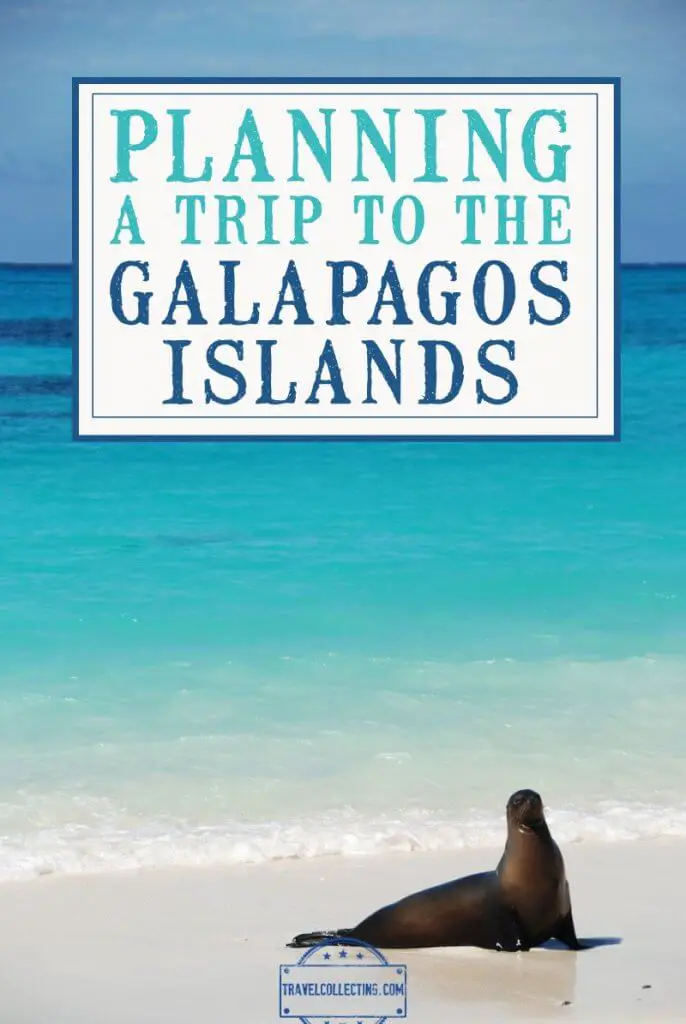
Be sure to read other Galapagos Islands posts:
- The Best Time to Visit the Galapagos Islands
- How to Choose the Best Way to See the Galapagos Islands
- How to Get To and Around the Galapagos Islands
- Where to Stay in the Galapagos Islands
- Recommended Galapagos Activities
About the author

James Ian has traveled to 82 countries and all 7 continents. He is passionate about experiential travel, i.e. meaningful travel that actively engages with the environment and culture. He helps people have similar experiences that involve active participation in activities and festivals; engaging with the local food and handicrafts through lessons and food tours; and interacting positively with environment by hiking, riding, rowing, diving and low/no impact animal encounters.
Travel Collecting is a participant in the Amazon.com Services LLC Associates Program, an affiliate advertising program designed to provide a means for sites to earn advertising fees by advertising and linking to amazon.com. Amazon and the Amazon logo are trademarks of Amazon.com, Inc. or its affiliates.








